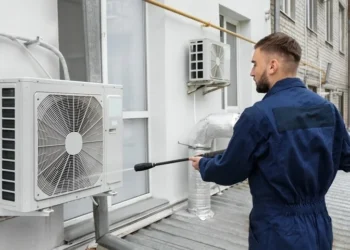For a long time ago, metal railings have been primary in both domestic and trading architecture, appreciated for their roughness, longevity, and visual appearance. Yet, similarly to any substance, metal railings derive their own set of benefits and drawbacks. This article will elaborate on the advantages and disadvantages of metal railings with an emphasis on three vital aspects: durability, maintenance, and aesthetics.
Durability
Metal railings are strong
Metal railings, specifically those that originated from steel or ironmongery, are amazingly tough and can handle a noteworthy amount of mass. By using these materials, it makes them perfect for heavy traffic zones or regions where security is a main concern, such as ladders, terraces, and verandas.
Metal railings are weather resistance
It is vital to mention that plenty of metal railings are processed with coverings which result in resilience to climate elements such as rain, snow, and UV rays. Stainless steel and aluminum railings, for example, do not corrode easily and can resist severe weather situations without worsening.
Metal railings offer superior structural Integrity
Metal railings uphold their skeletal truthfulness over time, offering steady support and safety. Apart from wood, which can fold, fracture, or corrosion, metal stays constant and consistent.
Metal railings have a high corrosion risk
Regardless of their last-longing, some metals like iron are vulnerable and rust if not appropriately preserved. This is specifically right in seaside parts where seawater revelation is usual.
Metal railings might be expensive
The primary cost of metal railings can be elevated contrasted to other materials such as wood or vinyl. This can be a noteworthy thought for economic projects.
Metal railings are weighty
Metal railings can be weighty, making them more arduous to set up. This might demand qualified fixing, adding to the total cost.
Maintenance
They are Low Maintenance
Various metal railings need minimal preservation. For example, alum railings do not corrode and often only require sporadic cleaning to keep their look. Corrosion-resistant steel is also recognized for its minimal care necessities.
Even though the first cost might be higher, the minimal maintenance required of metal railings can point to long-range savings. There’s no necessity for everyday painting, covering, or replacing defective parts as you might encounter with wood or other metals.
Metal railings are mostly easy to keep clean. Everyday soap and water are often enough for the usual cleaning. For strong stains, there are particular cleansers that can repair the metal’s gleam without harming it.
They can be difficult to repair
When metal railings do need repairs, they can be more complex than other materials. Repairing or particular skills might be obligatory to fix harm, which can be expensive and time-consuming.
They have special cleaning needs
Some metal fences, mainly those with complex designs, might need more meticulous cleaning to eliminate dirt and grime from small gaps. This can be more work-intensive in comparison to cleaning basic railing designs.
Aesthetics
They have a modern and classic appeal
Metal railings provide a multipurpose visual that can balance both up-to-date and classic architectural elegances. Shiny stainless-steel railings are popular in modern designs, while decorative-shaped iron railings can enhance a touch of style to out-of-date settings.
They have customization options
Metal railings can be extremely modified to match individual favorites. They can be created in a wide range of forms, designs, and finishes. Powder coating, for example, can offer a diversity of nuances and textures, improving the pictorial appeal.
They provide transparency and light
Different from huge wooden railings, metal railings can be shaped to be less blocked. Cable railings or those with sensitive metal spindles allow for better visibility and bright passage, making a sense of transparency in the space.
They have a cold appearance
Some individuals consider metal railings to have an unfriendly manufacturing appearance, which might not be appropriate for all locations. This can be alleviated by joining metal with other materials, such as wood or glass, to soften the appearance.
They are limited when it comes to design
While metal railings can be tailored, there are assured limits in terms of molds and forms compared to elements like wood, which can be more simply sculptured or shaped into complicated designs.
They can be very trendy
Specific metal railing models can be very fashionable, which might not be the trial of time. What is trendy today might seem old-fashioned in a few years, demanding a design update sooner than predictable.
Additional Considerations
An additional significant aspect to reflect is the environmental influence of metal railings. Metals like aluminum and steel are reusable, manufacturing them a more renewable choice in comparison to single-use materials. Selecting recycled metal can decrease the environmental footmark of your project, assisting in a more maintainable structure practice.
Safety is another crucial factor. Metal railings are often preferred in civic and profitable spaces because they offer vigorous safety features. They can be made to meet severe security codes and values, guaranteeing that they provide trustworthy safety in areas like stairs, terraces, and verandas. The sturdy and durability of metal railings make them a favored choice in settings where security is a top priority.
Conclusion
In conclusion, steel railings offer a persuasive mixture of longevity, low care, and visual flexibility. They are predominantly well-matched for surroundings where robustness and durability are dominant, and where the visual attractiveness of sleek, up-to-date materials is wanted. However, potential disadvantages such as vulnerability to rust, elevated initial fee, and the need for sporadic specialized care should also be counted.
For those looking to invest in metal railings, it’s central to balance these perks and pitfalls wisely. Ponder the specific ambient conditions, upkeep abilities, and artistic goals of your project. Consequently, you can make an up-to-date decision that harmonizes both the feasible and visual features, guaranteeing that your choice of railings fulfills both your practical needs and design ambitions. In the end, the right solution of railing can elevate the safety, attractiveness, and value of your property, making it a valuable capital for the future.












